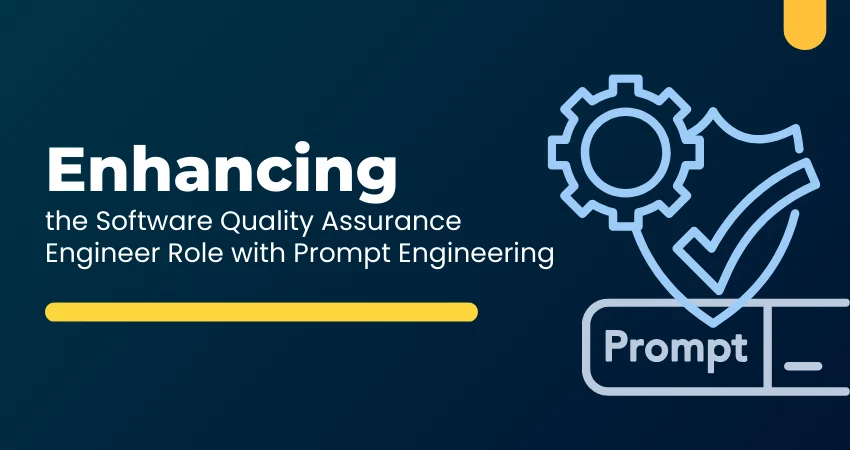Enhancing the Software Quality Assurance Engineer Role with Prompt Engineering

Introduction
Software Quality Assurance (QA) engineers play a critical role in ensuring the reliability, functionality, and performance of software applications. With the rapid advancements in artificial intelligence (AI), QA processes are evolving, and one of the most transformative technologies in this space is prompt engineering. By effectively leveraging AI-powered language models, QA engineers can enhance test case generation, bug reporting, automation, and overall software quality. This article explores how QA engineers can integrate prompt engineering into their workflows, with real-world examples and best practices.
Understanding Prompt Engineering
Prompt engineering refers to the practice of designing effective inputs (prompts) to guide AI models like ChatGPT, Bard, or other LLMs (Large Language Models) to generate accurate and useful outputs. The quality of responses from AI depends largely on how prompts are framed. For example, asking an AI, "Find test cases for a login page" may yield generic results, but refining the prompt to "Generate detailed test cases covering positive, negative, and edge cases for a login page, including invalid inputs and security vulnerabilities" will produce more valuable insights.
Why QA Engineers Should Leverage Prompt Engineering
- Automated Test Case Generation QA engineers can use AI to generate test cases based on user stories or software requirements. Instead of manually brainstorming test scenarios, a well-structured prompt can extract meaningful cases in seconds. For instance, an AI prompt like "List all possible edge cases for a checkout process with multiple payment methods" can save significant time in test design.
- Enhancing Bug Reporting and Root Cause Analysis Detailed bug reporting is crucial in software development. AI-assisted prompts can help generate structured bug reports by summarizing logs, stack traces, and reproduction steps. For example, a QA engineer can input, "Summarize this error log and suggest potential root causes", allowing AI to analyze patterns and provide insights.
- Optimizing Test Automation AI-powered tools can assist in writing and optimizing automated test scripts. A QA engineer can prompt AI with, "Convert this manual test case into a Selenium Java test script", and get a structured script as output, significantly reducing script development time.
- Requirement Analysis and Ambiguity Detection Detecting ambiguities in requirements early can prevent costly defects. QA engineers can prompt AI with, "Analyze this requirement document and highlight any vague or conflicting statements", leading to clearer requirements and better test planning.
Real-World Applications of Prompt Engineering in QA
Example 1: Generating Comprehensive Test Cases
A QA team working on an e-commerce platform can use AI to generate test cases for various functionalities, such as login, checkout, and order tracking. Instead of manually listing scenarios, they can prompt AI with, "Generate functional and non-functional test cases for an e-commerce checkout page" and receive a detailed list covering UI, security, performance, and edge cases.
Example 2: AI-Assisted Exploratory Testing
Exploratory testing requires creativity and critical thinking. QA engineers can leverage AI to suggest unexpected test scenarios. A tester could ask, "Suggest out-of-the-box exploratory test cases for a new banking app feature", leading to innovative testing approaches.
Example 3: Auto-Generating Regression Test Cases
Instead of maintaining lengthy regression test documents, a QA engineer can prompt AI with, "List all test cases impacted by the latest changes in the login module", enabling quicker adaptation to software updates.
Best Practices for QA Engineers Using Prompt Engineering
- Be Specific and Clear: Clearly define the scope and expected outcome of AI-generated responses.
- Use Iterative Prompting: Refine and iterate on prompts to get improved responses.
- Combine AI with Human Validation: AI-generated content should always be reviewed for accuracy.
- Leverage AI for Documentation: Use prompts to auto-generate test documentation, reports, and summaries.
Challenges and How to Overcome Them
While AI can significantly enhance QA processes, challenges exist:
- Accuracy Concerns: AI-generated test cases or bug reports may not always be correct. Human oversight is essential.
- Security Risks: Using AI for sensitive data analysis should comply with security and privacy guidelines.
- Over-Reliance on AI: AI should be an assistant, not a replacement, for human-driven QA expertise.
Conclusion
The integration of prompt engineering into the QA role presents exciting opportunities to enhance efficiency, accuracy, and innovation in software testing. By crafting effective prompts, QA engineers can automate test case generation, improve bug reporting, and optimize test automation. While challenges exist, best practices can ensure AI complements human expertise rather than replacing it. As AI continues to evolve, mastering prompt engineering will become a valuable skill for QA professionals, enabling them to stay ahead in the ever-changing landscape of software quality assurance.